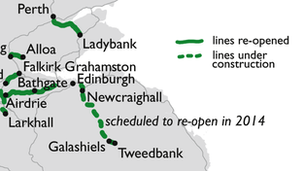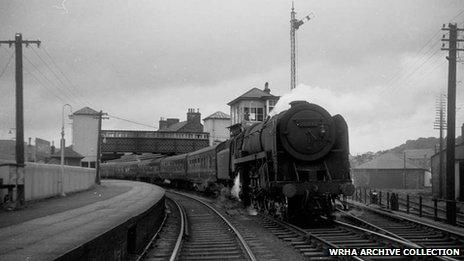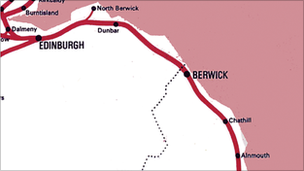The Scottish Borders: A region without railway stations
- Published

By the late 19th century almost every major population centre in the Borders had a railway station
Would you like to see my maps of the railways?
As conversational opening gambits go, it is not the kind of statement likely to fire you to the top of the guest list for a dinner party.
Or, if you are already at a social gathering, it probably won't get you invited back.
And yet, the pictorial history they offer of the expansion, contraction, disappearance and planned revival of train travel in the Scottish Borders is - to my mind at least - an intriguing one.
The story of the Britain's railways is one which gathered pace in the early 19th Century.
In 1825, the Stockton and Darlington became the first railway in the world to operate a freight and passenger service with steam traction.

Work is now under way to have railway stations return to the Borders after more than 40 years
Five years later, the Liverpool and Manchester Railway became, according the the Encyclopaedia Britannica, the "first fully evolved railway to be built".
It signalled an explosion of rail construction, the start of which is captured in the recently republished Bradshaw's Railway Map of 1839.
The only link it shows between Scotland and England via the Borders is the Edinburgh to Berwick line, although it was not opened until 1846.
That was the beginning of the region's involvement with train travel.
It might never have expanded much further, as David Spaven, author of Mapping the Railways, points out.
He said a Royal Commission of the time reckoned that the only routes needed linking Scotland and England were the main east and west coast lines.
"Little did they realise that by building new rail lines it would generate new traffic," he said.
So, by 1849, the North British Railway Company had opened a stretch of its Waverley Line from Edinburgh to Hawick and later extended it to Carlisle.
Mr Spaven argues that the decision to take that southern section through less populated areas - rather than through Langholm - might ultimately have cost its very existence.
However, it initially opened up another slice of the Borders to rail traffic.
A series of maps published over time shows how the routes quickly expanded to criss-cross the region like veins in the human body.
By the end of the 19th century and into the early 20th century the service had clearly reached its peak with branch lines sprouting.
It is easy to pick out stopping points at Hawick, Eyemouth, Selkirk, Jedburgh, Kelso, Coldstream, Duns, Galashiels, Melrose, Peebles, Lauder and more.
In other words, pretty much every major population centre in the Borders.
However, that "golden age" would not last.
By the 1950s, Mr Spaven says, people were "deserting the railways" and action was taken the following decade in the form of the Beeching Reports.
They came up with what the author describes as a "somewhat crude solution" to the problem - the closure of numerous lines and stations.
"People often make the comparison with chopping all the branches off a tree," Mr Spaven explained.
The axe did not fall everywhere with the same destructiveness.
A "vociferous campaign" saw many stations in the Highlands retained but the Borders lost all of its stopping points suffering what Mr Spaven calls a "great regional injustice".

The closure of the Waverley Line in the late 1960s meant passenger trains could no longer stop in the Scottish Borders
By 1969, the last stations in the Borders had closed.
"Seventy-five thousand people or more were completely isolated from the rail network," said Mr Spaven.
It is now the only mainland region of Great Britain without a railway station.
It might not seem like such a deprivation and yet it is a thought worth mulling over.
I was born in the last year trains stopped in the Borders but, in contrast, I have never lived anywhere where I was far removed from a station.
In Dumfries, Edinburgh, Darlington and Borgo San Lorenzo near Florence, I have never been much more than a 20-minute walk from a spot where I could catch a train.

A map from the late 1960s shows how stations had disappeared from the map in the Borders
The service might not always have been run at the times I would have liked it or been as luxurious as I would have wished but, at least, it was there.
I suspect most of us have, at one time or another, grumbled about the trains or railway network but most of us have access somewhere near at hand.
But in the Scottish Borders the only way to catch a train is to leave the region.
They still pass through - on the East Coast Main Line - but you would have to jump aboard a moving vehicle if you hoped to catch one within the boundaries of the Borders.
It was this situation which meant that, by the 1990s, a campaign had begun to reopen the old rail route to the area and, slowly but surely, it gathered momentum.
Eventually, the bill was passed which would allow construction of track linking Edinburgh as far as Tweedbank.
It is hoped it will be completed and passengers making journeys by 2014 - some 45 years after they last did so.
Some people view that as putting right a long-standing wrong but others reckon that it will either never happen or - at a price estimated around £295m - that it does not represent value for money.
If nothing else, however, it's another topic for debate over dinner - after you have looked at those old railway maps, of course.
- Published21 March 2012